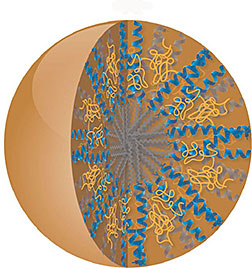- Number 454 |
- December 14, 2015
Nanocarriers may carry new hope for brain cancer therapy

At only 20 nanometers and featuring a
unique hierarchical structure, 3HM
nanocarriers developed at Berkeley Lab
meet all the size and stability requirements
for effectively delivering therapeutic drugs
to brain cancer tumors.
Glioblastoma multiforme is a cancer of the brain that is virtually inoperable, resistant to therapies, and always fatal, killing approximately 15,000 people in the United States each year. One of the major obstacles to treatment is the blood brain barrier, the network of blood vessels that allows essential nutrients to enter the brain but blocks the passage of other substances. Ting Xu, a scientist at DOE's Berkeley Lab who specializes in the creation of self-assembling bio/nano hybrid materials, has developed a new family of nano-sized vessels that can effectively carry a therapeutic drug across the blood brain barrier and deliver it to glioblastoma multiforme tumors. These new nanocarriers are called “3HM” for coiled-coil 3-helix micelles. (Full story)
[Lynn Yarris, 510.486.5375,
lcyarris@lbl.gov]
